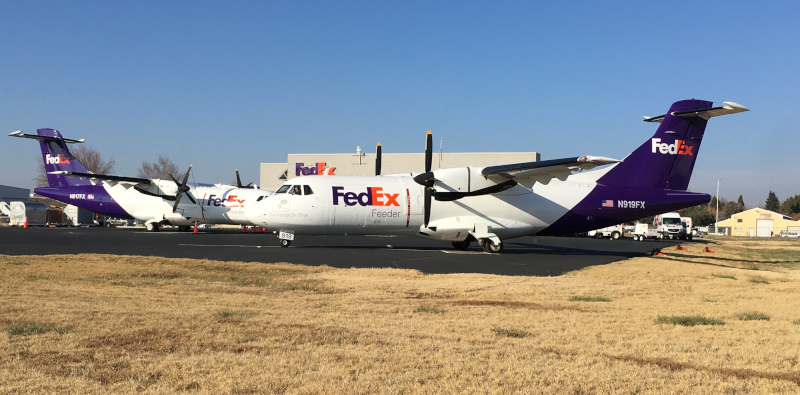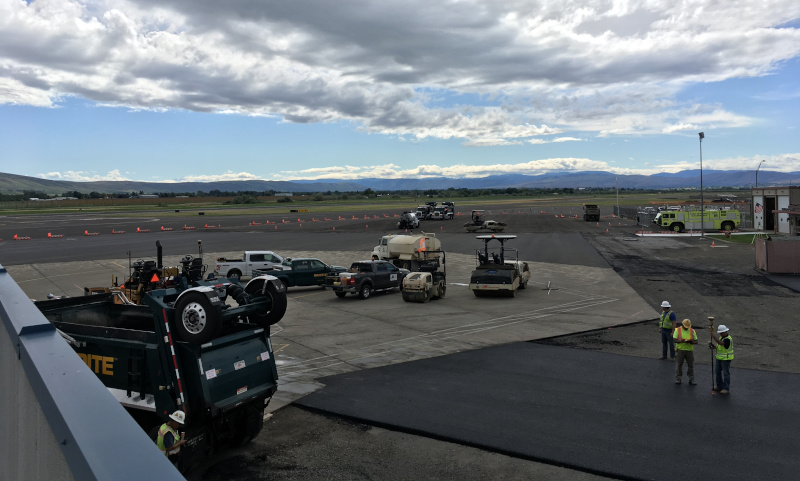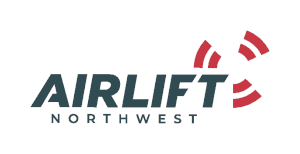The Yakima Air Terminal-McAllister Field
Growing pretty good
Business View Magazine interviews Robert K. Peterson, Airport Director at the Yakima Air Terminal, as part of our series on U.S. regional airports.
The Yakima Air Terminal-McAllister Field, a primary commercial service airport with a strong general aviation presence, is three miles south of the City of Yakima in Yakima County, Washington has been an important gateway to and from the Yakima Valley since the 1920s. Originally an 80-acre field of sagebrush, the Airport, once known as McAllister Field, was improved in 1932, by adding a 2,600-ft.-long gravel landing strip with a drainage system. Shortly afterward, the Airport was graded and surfaced for two runways, both of which were just over 3,000 feet. In 1940, the old runways were converted into taxiways and a new 5,000-ft. runway, as well as a second 4,000-ft. runway, was completed. In 1949, a new passenger terminal was constructed, which also housed the Federal Aviation Administration (FAA) control tower and the local National Weather Service office. In 1974, the FAA built a new control tower and in 1953, its first Instrument Landing System was installed.
Air transportation services available at Yakima include commercial air service provided by Alaska Airlines, charter air service provided by Swift Air and Sun Country Airlines, air cargo service provided by FedEx and United Parcel Services, emergency medical flights, aircraft manufacturing and testing, corporate aviation, and general aviation. Today, about 132 GA aircraft are home-based at Yakima where they positively impact the airport’s +40,000 annual aircraft operations.
The Airport has a high economic impact on the local economy and supports many aviation businesses that provide an estimated 1,000 jobs for the community. These businesses include the McAllister Museum of Aviation; the McCormick Air Center, the Airport’s FBO; Renos on the Runway; Food Facility Engineering which designs cold storage facilities; PocketiNet which provides the valley with high speed internet; ALS Ambulance Service; Virginia Mason Memorial Medical Facility; WaterFire Restaurant, Wilson Orchard and Vineyard Supply; CubCrafters, which designs and manufactures experimental, light sport, and FAA-certified Part 23 aircraft; Triumph Actuation Systems, a manufacturer of aircraft hydraulic actuation systems and components; Airlift Northwest, a not-for-profit service of the University of Washington School of Medicine and Harborview Medical Center that provides flight transport via helicopter and fixed wing aircraft for patients needing intensive medical care in Washington, Idaho, Montana, and Alaska; and Yakima Aerosport, specializing in the construction and repair of aircraft.

Airport Director, Robert K. Peterson, reports that Yakima Airport’s Master Plan, which was first promulgated in 2015, has recently been updated in order to better identify the Airport’s future development, any projects and/or expansions that need to be accomplished, and any alternatives to the plan, which will help the Airport meet the current and future needs of the Yakima aviation community.
“The FAA has accepted the forecast chapter, which is critical to make sure that they understand the future demands and needs, not only for air service development, but also additional facilities that we may need to house additional aircraft,” Peterson reports. “So, that project is coming along well with the FAA, as well as with the tenants here at the Airport. We had an open house in November with our tenants and the community to identify future growth needs, as well as the alternatives to meet the Airport’s critical needs and expansion efforts. Additionally, we included our Airport’s electronic Geographical Information System data implemented in the FAA’s website, which identifies critical details on the Airport, such as where your hangars are located, your runways, your taxiways, and all your associated facilities. Tentatively, the Airport Layout plan update will be completed in the spring of 2020 with the City adopting the plan in the fall.”
Peterson remarks that a main priority for the Airport is the replacement and/or upgrading of any aging infrastructure. Several recently completed projects include: a $1.9 million rehabilitation of 22,000-sq.-yds. of asphalt on the west general aviation apron around the terminal building; an update of water and sewer lines to the terminal building; and the installation of two new floodlights on the west general aviation apron.
Upcoming projects include a new high-intensity lighting system for Runway 9/27. “We’re in the design phase, right now,” says Peterson. “That will be completed in August 2020, at a tune of about $1.5 million. And we’re excited to do this because the FAA recently approved LED high-intensity runway edge lighting systems to be eligible under the Airport Improvement Program. So, we will be one of the first airports in the State of Washington to implement this new system under the program. In addition to new runway edge lights we will complete a crack and fog seal on Runway 9/27, while updating the Runway surface markings. Finally, the project will replace one of our windsocks for Runway 9 in order to provide pilots with important wind direction and speed. In 2021, we’ll redo the east general aviation apron, similar to our completed west general aviation apron at approximately $2.5 million.”
The construction of new hangars is also top of mind. Last month, the Airport submitted a proposal to the Yakima city council for new T-hangars which was approved during their November meeting. “McCormick Air Center has led the way on this,” says Peterson. “Ultimately, they want to build additional T-hangars to facilitate growth here at the Airport, which will be located on the west side of the Airport. Ultimately, this will allow them to free up a lot of space in other hangar facilities to allow larger aircraft in their corporate hangars.”
Remarking on the demand for new space, Peterson continues, “The Department of Natural Resources has recently relocated two Huey helicopters, here, to respond to any type of wildfires in the valley, which is a value asset. They actually took one of McCormick’s corporate hangars, and they’re operating out of that, which displaces a variety of single engine aircraft out onto the ramp because we just didn’t have the space for them. Additionally, we’ve been contacted by Life Flight, which is an air ambulance organization to base a helicopter here. So, ultimately, we ran out of space and could not house their facility because they need dorm rooms and an operations center, as well as a hangar to keep the helicopter in. So, we are looking to build those hangars as fast as we can so that we can reach out to other interested parties and facilitate a long term lease, like with Life Flight. We already have Airlift Northwest here, but it’s good to have an additional helicopter here, just in case there’s any type of emergency response needed in the valley.”

Meanwhile, the Airport has continued to gear up its snow operations for the winter season. “About three weeks ago, we received two high-speed runway brooms from MB Companies at about $1.2 million,” Peterson notes. “And we acquired a high capacity snow blower last fall, which helped out a lot during the winter season, last year. So now we have a complete fleet of updated equipment – three high-speed runway brooms, a high capacity blower that removes 7,500 tons of snow per hour, and we have liquid de-icer, as well as four plows available, and a ramp plow. So, we are all set for the winter operations with a way to make sure that we can remove snow in time to maintain safety for Alaska Airlines flying in and out, as well as a lot of the cargo and corporate operations.”
At Yakima, safety is an important consideration, year round. “We recently received a grant from the FAA for an Aircraft Rescue and Fire Fighting (ARFF) rig,” Peterson relates. “They have a contract with Oshkosh Airport Products – one of the leading representatives for developing these large aircraft rescue and firefighting apparatuses. The contract was for about $761,000, and with that, there’s about another $250,000 – so it’s about a million dollars worth of investment for the rig, as well as the supplemental auxiliary equipment that goes with it – pipes, hoses, crash truck supplies, as well as the personal protective equipment. This rig will be delivered around winter or spring of 2021. We’re really excited to have that new rig, which will replace our 1986 Oshkosh T-1500 rig as well as increase safety at the Airport.”
An important part of Peterson’s agenda has always been community outreach. Last year, he reports that there were several public events held to educate the community on aeronautical or aviation opportunities. “One was the Washington Pilots Association that had their chapter fly-in,” Peterson recounts. “We saw about 20 aircraft fly in and do a tour of the CubCrafters facility, as well as the McAllister Museum. We also had our annual Wings and Freedom tour come in July, which allowed the public to come in to see these unique World War II aircraft – we had a P-51, a P-40, a B-24, a B-17, and a B-25 here. It was amazing and well-attended.
“And then, this past fall, although it was not open specifically to the public, but to the aviation industry, was something called CubFest 2019, which is our aircraft manufacturing plant here in Yakima. They produce unique, two-seater aircraft that are known in the bush areas like Alaska where they fly into remote areas and can take off in a short distance. They were celebrating a 10th anniversary of the Carbon Cub. (The Carbon Cub is supplied as a kit for amateur construction.) We saw about 250 people attend that event. It was an opportunity to recognize all the hard work and efforts that they’ve done in their manufacturing line.
“And we still do our outreach program for our Central Washington University Aviation division, where we provide various airport tours. We had the opportunity to coordinate a joint operation with Spokane International Airport for one of their classes. We went there to do a tour of their facilities, back in May. It was a good opportunity to get those students exposed to the aviation industry and allow us to meet the future demands for professional pilots, as well as mechanics.”
Finally, Peterson reports on some of the growth experienced by various Airport tenants: “CubCrafters, which is the number two aircraft manufacturing plant in the State of Washington after Boeing, recently leased a 28,000-sq.-ft. hangar facility for a completion hangar. If you buy one of their kits, they help you do the final assembly of their aircraft in this facility. Then, you have the opportunity to fly your own aircraft out. So, it’s a wonderful addition to their facility. FedEx recently expanded their facility – parking-wise. Instead of flying the Cessna Caravans in, they have upgraded to an ATR-42 or a 72 aircraft. We’ve seen an increase in overnight package deliveries here within the valley where businesses continue to grow.
“We have few other businesses that have expanded at the Airport. We have Reno’s on the Runway – they lease a 1,450-sq.-ft. building, which is actually Northwest Airline’s original terminal building from the 1930s. They renovated it and now they have a restaurant. This makes the third restaurant on the Airport. We have WaterFire; we have Kyoto’s right across the street that’s leasing some property on the Airport; and now Reno’s on the Runway.
“We have two more businesses – Castle Coffee, which is adjacent to the terminal building. That person is developing a coffee stand. Everybody in Washington likes their coffee. Finally, Food Facility Engineering is a manufacturing and engineering corporation that develops and helps engineer cold storage facilities throughout the United States. They’ve been housed here in Yakima ever since they were born and they’re looking to expand. They’re renovating approximately 4,300 square feet of the second floor terminal building, which used to be the old restaurant. They’re going to turn that into their main operations office. It’s a great addition to have them here at the Airport. So, for a small airport, we’re growing pretty good.”
AT A GLANCE
WHO: Yakima Air Terminal
WHAT: A general aviation and commercial airport
WHERE: Yakima, Washington
WEBSITE: www.flyykm.com
PREFERRED VENDORS
Airlift Northwest – airliftnw.org
After a tragic house fire in Sitka, Alaska, claimed the lives of three children, Dr. Michael Copass, then medical director of emergency services at Harborview Medical Center and Medic One in Seattle, founded the region’s first air medical transport service in 1982. His mission was to provide the highest level of critical care wherever and whenever it was needed.
As a not-for-profit service of UW Medicine, Airlift Northwest continues to be guided by that same founding passion to provide lifesaving care, especially in rural areas with limited access to emergency services. It puts into flight the latest discoveries, best training, and cutting edge technology.
Its core belief is that all people deserve high-quality critical care no matter where they live. They operate out of eight bases throughout Washington and Southeast Alaska, and work closely with local first responders and hospitals to transport 3,600 patients annually.
Airlift Northwest’s helicopters and airplanes are flying ICUs. They use equipment onboard that is typically only available in the best hospitals, including cardiac balloon pumps, extracorporeal membrane oxygenation (ECMO), neonatal isolettes, and blood and plasma that has been proven to increase survival rates.




